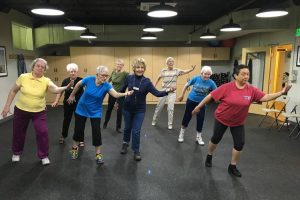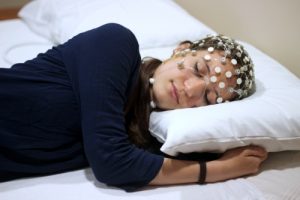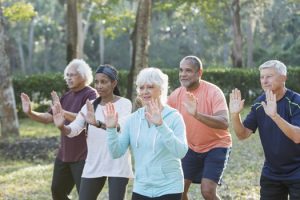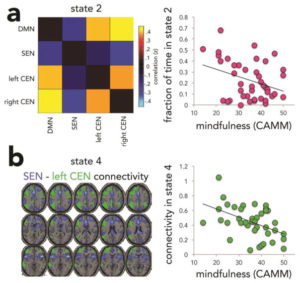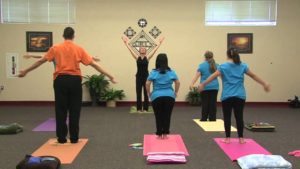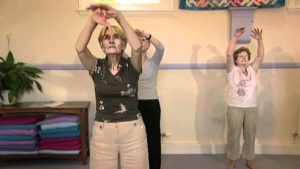Reduce Falls in the Elderly with Exercise and Tai Chi
By John M. de Castro, Ph.D.
“With regular practice, tai chi improves balance by strengthening muscles and co-ordination; at the same time, it strengthens the mind, thereby improving calmness and confidence in not falling. Thus, both physically and mentally, tai chi is an extremely effective exercise for fall prevention. A great bonus, at the same time, tai chi also improves almost all aspects of health!” – Paul Lam
The process of aging affects every aspect of the physical and cognitive domains. Every system in the body deteriorates including motor function with a decline in strength, flexibility, and balance. Impaired balance is a particular problem as it can lead to falls. In the U.S. one third of people over 65 fall each year and 2.5 million are treated in emergency rooms for injuries produced by falls. About 1% of falls result in deaths making it the leading cause of death due to injury among the elderly.
Falls, with or without injury, also carry a heavy quality of life impact. A growing number of older adults, fear falling and, as a result, limit their activities and social engagements. This can result in further physical decline, depression, social isolation, and feelings of helplessness. It is obviously important to discover methods to improve balance and decrease the number of falls in the elderly.
Tai Chi training is designed to enhance and regulate the functional activities of the body through regulated breathing, mindful concentration, and gentle movements. It includes balance training and has been shown to improve balance and coordination. Indeed, Tai Chi training has been shown to reduce the frequency of falls in the elderly. It is not known, however, how effective Tai Chi training is in preventing falls relative to other exercises. The evidence is accumulating. So, it is important to review and summarize what has been learned.
In today’s Research News article “Exercise for preventing falls in older people living in the community.” (See summary below or view the full text of the study at: https://www.ncbi.nlm.nih.gov/pmc/articles/PMC6360922/), Sherrington and colleagues review, summarize, and perform a meta-analysis of the relative effectiveness of various exercises, including Tai Chi in improving balance and reducing falls in the elderly. They identified 108 randomized controlled trials including a total of 23,407 participants averaging 77 years of age employing any form of exercise and measuring falls before and after treatment.
They report that the published research found that all forms of exercise combined significantly reduced falls by 23% and reduced the number of people experiencing falls by 15% with larger effects when the program was delivered by a health care professional. With respect to specific forms of exercise they found that balance and functional exercises significantly reduced falls by 24% and reduced the number of people experiencing falls by 13% while Tai Chi significantly reduced falls by 19% and reduced the number of people experiencing falls by 20%. There were too few studies with mixed resultsmof other forms of exercise such as walking, dance, strength exercises to evaluate their effectiveness.
These findings support the use of exercise to reduce falls in the elderly including the use of Tai Chi. Some advantages of Tai Chi include the facts that it is not strenuous, involves slow gentle movements, and is safe, having no appreciable side effects, it is appropriate for all ages including the elderly and for individuals with illnesses that limit their activities or range of motion. It can also be practiced without professional supervision and in groups making it inexpensive to deliver and fun to engage in. This makes Tai Chi practice an excellent means to reduce falls in elderly individuals.
So, reduce falls in the elderly with exercise and Tai Chi.
“based on current available evidence, suggest that Tai Chi exercise is an effective intervention to prevent the risk of falls among older adults.” – Yu-Ning Hu
CMCS – Center for Mindfulness and Contemplative Studies
This and other Contemplative Studies posts are also available on Google+ https://plus.google.com/106784388191201299496/posts and on Twitter @MindfulResearch
Study Summary
Sherrington, C., Fairhall, N. J., Wallbank, G. K., Tiedemann, A., Michaleff, Z. A., Howard, K., Clemson, L., Hopewell, S., & Lamb, S. E. (2019). Exercise for preventing falls in older people living in the community. The Cochrane database of systematic reviews, 1(1), CD012424. https://doi.org/10.1002/14651858.CD012424.pub2
Abstract
Background
At least one‐third of community‐dwelling people over 65 years of age fall each year. Exercises that target balance, gait and muscle strength have been found to prevent falls in these people. An up‐to‐date synthesis of the evidence is important given the major long‐term consequences associated with falls and fall‐related injuries
Objectives
To assess the effects (benefits and harms) of exercise interventions for preventing falls in older people living in the community.
Search methods
We searched CENTRAL, MEDLINE, Embase, three other databases and two trial registers up to 2 May 2018, together with reference checking and contact with study authors to identify additional studies.
Selection criteria
We included randomised controlled trials (RCTs) evaluating the effects of any form of exercise as a single intervention on falls in people aged 60+ years living in the community. We excluded trials focused on particular conditions, such as stroke.
Data collection and analysis
We used standard methodological procedures expected by Cochrane. Our primary outcome was rate of falls.
Main results
We included 108 RCTs with 23,407 participants living in the community in 25 countries. There were nine cluster‐RCTs. On average, participants were 76 years old and 77% were women. Most trials had unclear or high risk of bias for one or more items. Results from four trials focusing on people who had been recently discharged from hospital and from comparisons of different exercises are not described here.
Exercise (all types) versus control
Eighty‐one trials (19,684 participants) compared exercise (all types) with control intervention (one not thought to reduce falls). Exercise reduces the rate of falls by 23% (rate ratio (RaR) 0.77, 95% confidence interval (CI) 0.71 to 0.83; 12,981 participants, 59 studies; high‐certainty evidence). Based on an illustrative risk of 850 falls in 1000 people followed over one year (data based on control group risk data from the 59 studies), this equates to 195 (95% CI 144 to 246) fewer falls in the exercise group. Exercise also reduces the number of people experiencing one or more falls by 15% (risk ratio (RR) 0.85, 95% CI 0.81 to 0.89; 13,518 participants, 63 studies; high‐certainty evidence). Based on an illustrative risk of 480 fallers in 1000 people followed over one year (data based on control group risk data from the 63 studies), this equates to 72 (95% CI 52 to 91) fewer fallers in the exercise group. Subgroup analyses showed no evidence of a difference in effect on both falls outcomes according to whether trials selected participants at increased risk of falling or not.
The findings for other outcomes are less certain, reflecting in part the relatively low number of studies and participants. Exercise may reduce the number of people experiencing one or more fall‐related fractures (RR 0.73, 95% CI 0.56 to 0.95; 4047 participants, 10 studies; low‐certainty evidence) and the number of people experiencing one or more falls requiring medical attention (RR 0.61, 95% CI 0.47 to 0.79; 1019 participants, 5 studies; low‐certainty evidence). The effect of exercise on the number of people who experience one or more falls requiring hospital admission is unclear (RR 0.78, 95% CI 0.51 to 1.18; 1705 participants, 2 studies, very low‐certainty evidence). Exercise may make little important difference to health‐related quality of life: conversion of the pooled result (standardised mean difference (SMD) ‐0.03, 95% CI ‐0.10 to 0.04; 3172 participants, 15 studies; low‐certainty evidence) to the EQ‐5D and SF‐36 scores showed the respective 95% CIs were much smaller than minimally important differences for both scales.
Adverse events were reported to some degree in 27 trials (6019 participants) but were monitored closely in both exercise and control groups in only one trial. Fourteen trials reported no adverse events. Aside from two serious adverse events (one pelvic stress fracture and one inguinal hernia surgery) reported in one trial, the remainder were non‐serious adverse events, primarily of a musculoskeletal nature. There was a median of three events (range 1 to 26) in the exercise groups.
Different exercise types versus control
Different forms of exercise had different impacts on falls (test for subgroup differences, rate of falls: P = 0.004, I² = 71%). Compared with control, balance and functional exercises reduce the rate of falls by 24% (RaR 0.76, 95% CI 0.70 to 0.81; 7920 participants, 39 studies; high‐certainty evidence) and the number of people experiencing one or more falls by 13% (RR 0.87, 95% CI 0.82 to 0.91; 8288 participants, 37 studies; high‐certainty evidence). Multiple types of exercise (most commonly balance and functional exercises plus resistance exercises) probably reduce the rate of falls by 34% (RaR 0.66, 95% CI 0.50 to 0.88; 1374 participants, 11 studies; moderate‐certainty evidence) and the number of people experiencing one or more falls by 22% (RR 0.78, 95% CI 0.64 to 0.96; 1623 participants, 17 studies; moderate‐certainty evidence). Tai Chi may reduce the rate of falls by 19% (RaR 0.81, 95% CI 0.67 to 0.99; 2655 participants, 7 studies; low‐certainty evidence) as well as reducing the number of people who experience falls by 20% (RR 0.80, 95% CI 0.70 to 0.91; 2677 participants, 8 studies; high‐certainty evidence). We are uncertain of the effects of programmes that are primarily resistance training, or dance or walking programmes on the rate of falls and the number of people who experience falls. No trials compared flexibility or endurance exercise versus control.
Authors’ conclusions
Exercise programmes reduce the rate of falls and the number of people experiencing falls in older people living in the community (high‐certainty evidence). The effects of such exercise programmes are uncertain for other non‐falls outcomes. Where reported, adverse events were predominantly non‐serious.
Exercise programmes that reduce falls primarily involve balance and functional exercises, while programmes that probably reduce falls include multiple exercise categories (typically balance and functional exercises plus resistance exercises). Tai Chi may also prevent falls but we are uncertain of the effect of resistance exercise (without balance and functional exercises), dance, or walking on the rate of falls.
https://www.ncbi.nlm.nih.gov/pmc/articles/PMC6360922/
